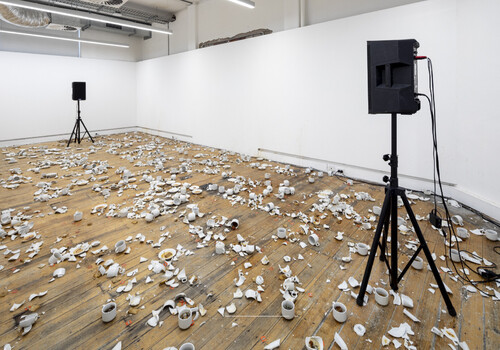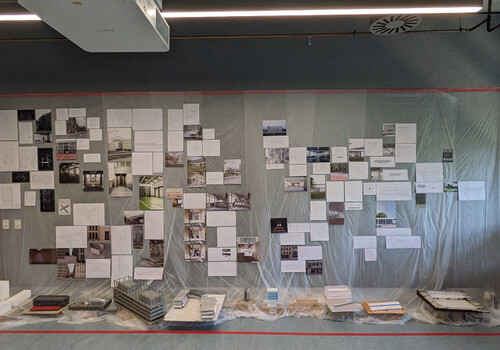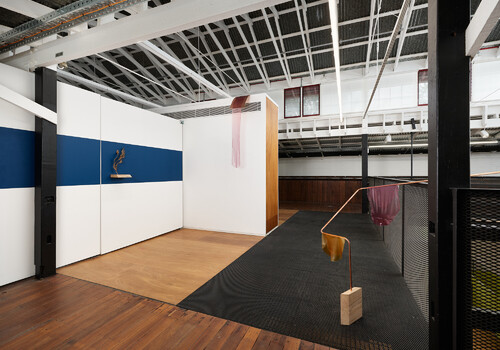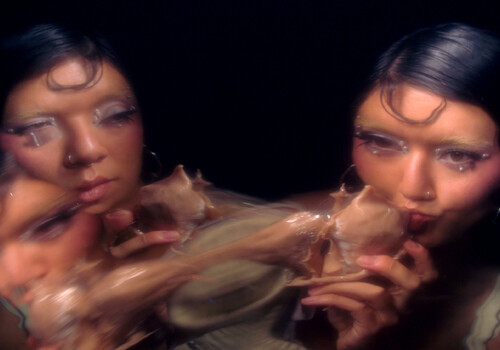Bachelor of Fine Art (Honours), UNSW Art & Design
By Siri Wingrove
The end-of-year rush has us all in its chokehold. At the UNSW’s The Annual 2024, however, hanging by a thread has never felt so purposeful. Aurelia King and Molly Holland’s suspended installations embody that fragile tension—tethered, albeit tenuously, yet with convincing purpose. Suspension isn’t passive here; it’s strategic. Its inherent instability demands focus, testing our collective obsession with control and permanence. Maybe that’s it—while much of the grad show feels securely anchored, these works urge us to hold our breath.

Installation view of Aurelia King, Irrational Mapping, 2024, Rice paper, thread, UNSW School of Art & Design, Sydney. https://annual.artdesign.unsw.edu.au/profile/aurelia-king. Photo: Jessica Maurer.
Aurelia King’s Irrational Mapping (2024) lingers in the gallery foyer, unsteady but poised. Two large sheets of layered rice paper hang from the ceiling, suspended by seven red threads, tied together with four neat bows. A map? Perhaps. But it is faceless, emptied out, wiped clean. Cartography is nowhere to be found. Maps typically signify control—simultaneously dictating space and asserting ownership.
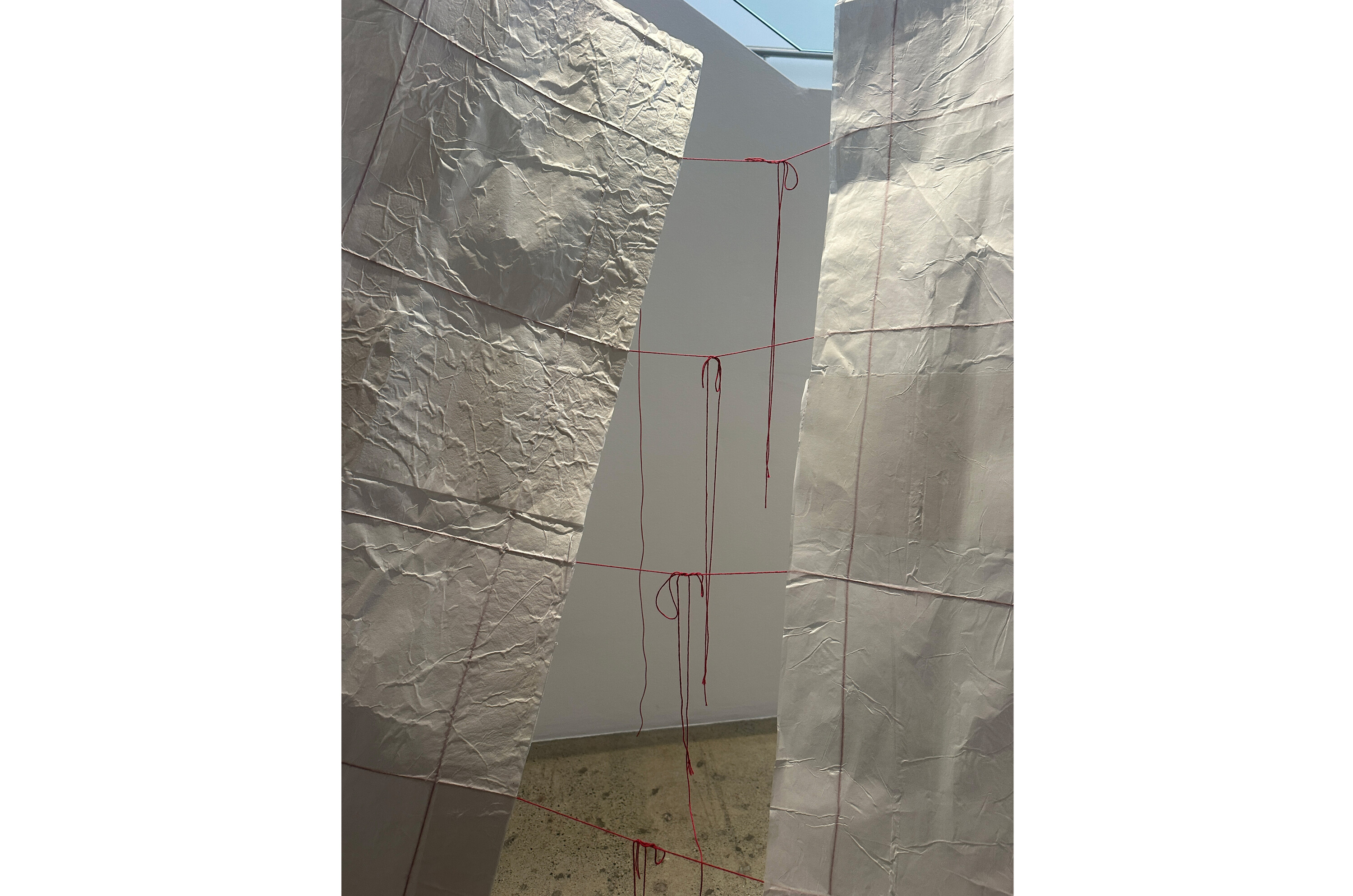
Aurelia King, Irrational Mapping, 2024, Rice paper, thread, UNSW School of Art & Design, Sydney. https://annual.artdesign.unsw.edu.au/profile/aurelia-king. Photo: Siri Wingrove.
Yet, unlike the rigid, immutable geography we are conditioned to trust (that digital map ever-present in our back pocket), King’s grid dances across the white expanse in a wobbly, hand-placed rhythm. The crisscrossing red threads evoke Taiwanese calligraphy paper, a reference to the artist’s cultural heritage. Here, the familiar coordinates of North, South, East, West dissolve, unmooring us from the Cartesian logic that often fixes our sense of place. The grid sags, threatening to collapse—an instability welcomed by King, even desired.
Across the room, erect and freshly printed maps detailing the exhibition layout are handed out at reception. “WHERE AM I?” is emblazoned on the front. I unabashedly rely on the latter map to navigate my journey across campus—an acknowledgment of the limits of King’s idealism. In practice, one still needs directions.

Installation view of Molly Holland, Hold On Me, 2024, Raw, fired, glazed and unglazed earthenware, resin, wire, stretch fabric, pantyhose, UNSW School of Art & Design, Sydney. https://annual.artdesign.unsw.edu.au/profile/molly-holland. Photo: Jessica Maurer.
Leaving UNSW galleries, I cross the courtyard to Molly Holland’s Hold On Me (2024) in AD space. A delicate, weblike structure clings to the back corner of the room, sprawling outward in scale. Stretched pantyhose form membrane-esque passageways, ensnaring lumps of clay like unwitting prey. Sculpted into oversized iridescent rocks, like those found while shell-hunting, the clay is alternately swallowed by and busting through the fabric. First impression: echoes of Ernesto Netos’s Just like drops in time, nothing (2022), on view in Naala Badu, AGNSW, where vast quantities of spices are suspended by industrial-strength pantyhose. Shared themes include fragility vs. force.
Second thoughts: Why am I suddenly reminded of an indoor rock-climbing centre? Third thoughts: After reconsidering the title, it’s clear—this is a self-portrait. A body under duress. Consuelo Cavaniglia, the Honours student’s sentinel, confirms this. This structure offers an intimate, haptic exploration of the mind-body connection. Unruly brambles of thought that stick to the hands and stain the intellect are bound together by a suspended corpus. On the brink of collapse, this work thrives.

Molly Holland, Hold On Me, 2024, Raw, fired, glazed and unglazed earthenware, resin, wire, stretch fabric, pantyhose, UNSW School of Art & Design, Sydney. https://annual.artdesign.unsw.edu.au/profile/molly-holland. Photo: Jessica Maurer.
Installation, especially at a grad show, often risks becoming unwieldy or frivolous, but not here. King and Holland sidestep that pitfall with ease and hold their own, literally. Taken together, both works rely on a similar aesthetic vocabulary of fragility and instability, creating liminal spaces that teeter on the edge.
As I leave AD, I am amused by a ripe banana duct-taped to the outside wall—a bootleg edition of Maurizio Cattelan’s now infamous 2019 work Comedian, which just sold for $6.2 million. With conceptual irony now fully commodified, I wonder: is sincerity the most valuable currency left for an art graduate?
Siri Wingrove is an emerging writer and curator based in Gadigal/Sydney. She is currently completing her Masters of Art Curating at The University of Sydney.




